Adequate light is the most important factor that should be considered when growing marijuana plants.
Just like using nutrients made for cannabis, quality light should be well supplied to your plants to enable proper growth.
To produce more cannabis buds, light is your secret weapon.
Using the correct wavelengths of light also ensures that the cannabis buds will be as potent as possible.
Cannabis is very light-sensitive, there is a need to adjust the light intensity, color, and frequency for each of its growth stages.
This emulates the natural conditions found in nature.
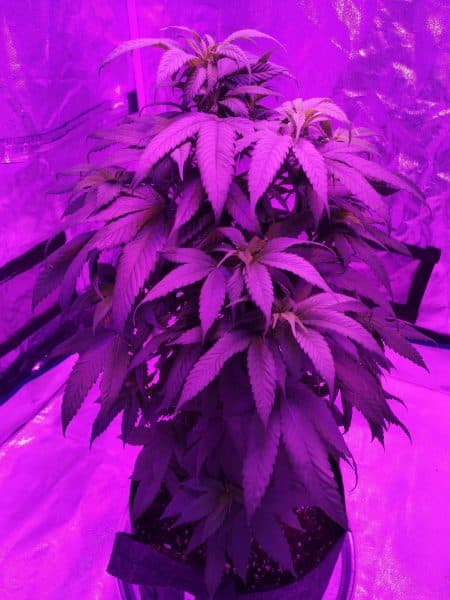
This is the reason indoor growers tend to buy a full-color spectrum of lights for their plants to maximize their budding and growing abilities.
In this article, we will answer the question of how does the light color spectrum impact growing cannabis. Let’s get started already, shall we?
The Light Color Spectrum
When we see a rainbow we are amazed at the beauty of all the colors. Rainbows are formed when white light is dispersed through water vapor. This refracted light breaks up into the individual colors that make up white light. Each one of these colors in the rainbow has a wavelength.
These different wavelengths of visible light are what make up the colors we see. The visual spectrum of light contains wavelengths that range from 700nm at the red end down to 400nm at the violent edge. “nm” stands for nanometers.
The reason things have color is that an object will absorb some wavelengths of light while reflecting others.
So for example, a green leaf will absorb all colors of light except for green. The green wavelength is reflected and we see that as color.
Black and white are not considered colors, they refer to shade and brightness. Black objects absorb all of the visible light spectra while white objects reflect it. This is why dark objects get hot faster on a sunny day, they absorb more light energy and give it off as heat.
I hope you’re still following me here. Light and color are two really interesting science topics. I encourage you to learn more about them if sciency stuff is your thing. This is a fairly basic explanation, but understanding how light and color work will help you make more informed choices when it comes to growing lights.
This chart shows what wavelengths of light chlorophyll A and B absorb from the light spectrum.
Chlorophyll A is the primary pigment used for photosynthesis. A will absorb violet-blue and orange-red light energy.
Chlorophyll B works as an accessory pigment that increases the amount of the light spectrum the plant can use as energy. It absorbs more blue light energy.
This chart shows an example of the different intensities of wavelength of the visible spectrum of daylight. Of course this will change on any given day and depend on the time of the season.
When the sun is lower in the horizon for longer periods (late summer and fall), plants receive more of the red and orange wavelengths.
These colors naturally trigger a plants ability to flower and produce fruit in an attempt to propagate before the cold winter months.
How Light Color Affects the Growth of Cannabis Plants?
There are lots of grow lights on the market and each has its pros and cons. If you have taken the time to pay keen attention, you will discover that many of these lights will offer different colors of light. This can sometimes be referred to as light temperature.
Natural sunlight provides the entire light spectrum. As the year moves along and seasons change the amount of wavelength energy changes. In the summer sunlight is heavy with green and blue wavelengths, while in the fall because of the shorter days and the sun being lower in the sky, it will give off more red light.
This change in wavelength intensity and duration is what tells plants and animals to prepare for seasonal changes. Cannabis plants are no exception.
Three Types of Common Grow Lights
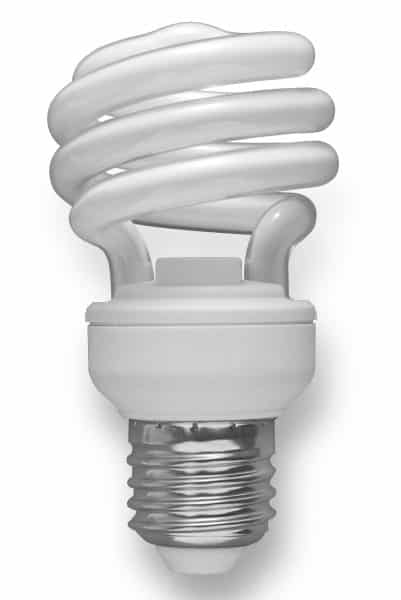
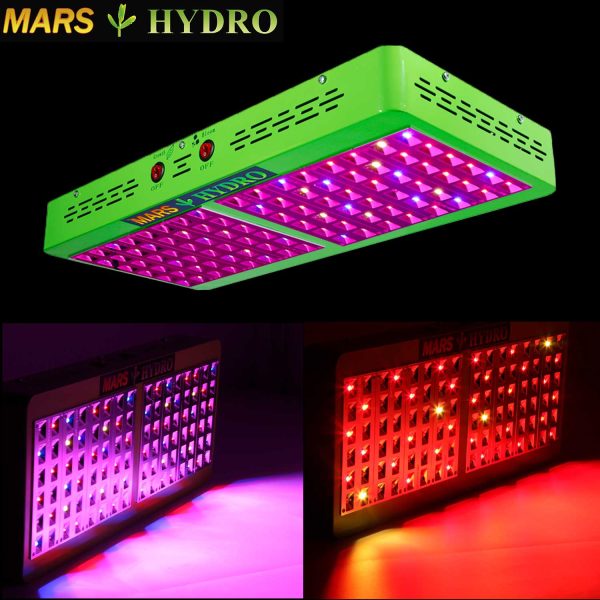
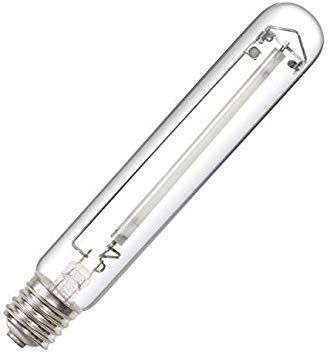
Cool White CFL Bulb
A great light for young cuttings and seedlings. The cool white varieties provide lots of blue spectrum light that promote new growth. These lights put out about 50 watts of energy which is inadequate for large scale cannabis growing but great for starting plants in smaller home grows.
Blue Red LED
These common LED light arrays usually range in power output from 100 watts to 1000. They provide lots of light energy at a smaller energy footprint than more traditional grow lights. Many come with a switch that will turn on more red light LED to help promote flowering.
HPS (High Pressure Sodium)
These lights gives off plenty of red, orange, and yellow light energy. This makes them perfect to use during the flowering phase when these wavelengths help with flowering.
When growing indoors you’re trying your best to emulate the perfect outdoor conditions. Each phase of a plant’s growth (from vegetative to flowering stage) is being exposed to various wavelengths of light to maintain the process of photosynthesis and bud formation. Understanding the natural changes in sunlight and how plants react can help you improve your growing skills.
For better clarity, let’s look at the various colors along the light spectrum, their corresponding wavelengths and how they impact marijuana plants. They include:
Ultraviolet Spectrum
Ultraviolet or UV light has a wavelength that ranges from 10nm to 400nm; this type of light energy is known to be harmful to human skin when they are exposed to it. Our bodies react by developing a tan in an attempt to block light from further damaging skin cells.
UV light in large amounts can also damage plants.
Two types of UV rays exist when it comes to growing cannabis; UV-A (315-400nm) and UV-B (280-315nm).
UV-A is considered harmful to marijuana plants. Regardless of its harmfulness (not just to cannabis but other plants as well), plants have evolved a natural defense mechanism against UV lights by secreting of enzymes, antioxidants, and chemicals to prevent more damage. However, at greater concentration, it’s still damaging to the plant.
UV-B on the other hand, when compared to UV-A, is far less harmful to cannabis plants. UV-B light seems to have a positive effect on cannabis plant growth. More research needs to be done to determine what the exact benefits are, but numerous growers swear that feeding plants UV-B light improves growth, flavor, and potency.
There are grow lights now which offer a full spectrum of visible light; that also includes infrared light and UV-B.
A third form of UV light called UV-C exists. In nature UV-C light is absorbed by the ozone before reaching the earth, and isn’t very useful for growing plants. UV-C light can harm plants and will kill micro-organisms and bacteria.
Violet Spectrum
Violet light is on the bottom end of the visual light spectrum. Its wavelength ranges from 380nm to 450nm. This range of light is considered to improve color, potency, and taste of flowers. Violet light isn’t a major growth factor compared to blue and red spectrum light.
“Blurples”
Many LED grow lamps will give off light that looks purple. These types of lamps are fondly known as blurples.
You would be wrong to think this was light from only the violet wavelength. Each LED bulb is designed to shine a specific wavelength of light. To maximize efficiency the entire lamp is made up of specific wavelengths LEDs that are connected to plant growth.
Blue and red are the most predominant but sometimes other wavelengths like UVB and white light are added in smaller numbers. When you combine red and blue light our eyes see the color purple.
Blurple LED lights give off very little of the violet wavelength.
Blue Spectrum
The blue spectrum of light is very important for cannabis plant growth. This wavelength lies between 450nm and 495nm. This color of light is best used at the sprout and vegetative stage of growth as it promotes rapid growth and development of the plant.
Outdoors during spring blue light energy is abundant. This is a natural trigger for new growth. It also keeps marijuana plants stable by helping them grow a strong stem and aids in the process of photosynthesis. Plants that are blue light deficient often turn out pale or yellow and are often weak flopping over under their weight.
Blue light can easily and quickly be supplemented by using cool white fluorescent bulbs, but most LED and alternative grow lights will provide blue light as well.
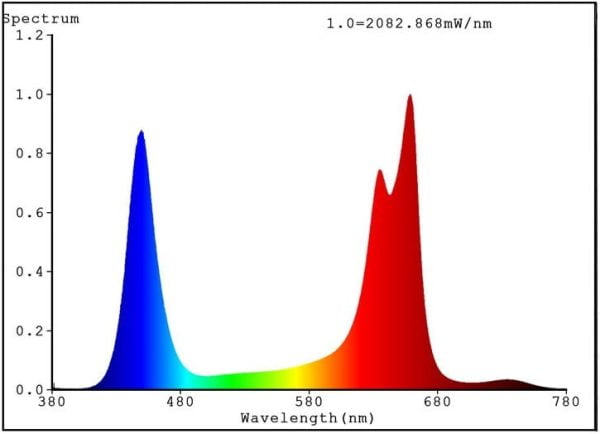
This graph shows the available light spectrum on a Mars Hydro LED (Mars Reflector 192).
As you can see it gives off a lot of blue and orange-red light. Fantastic for both veg and flower.
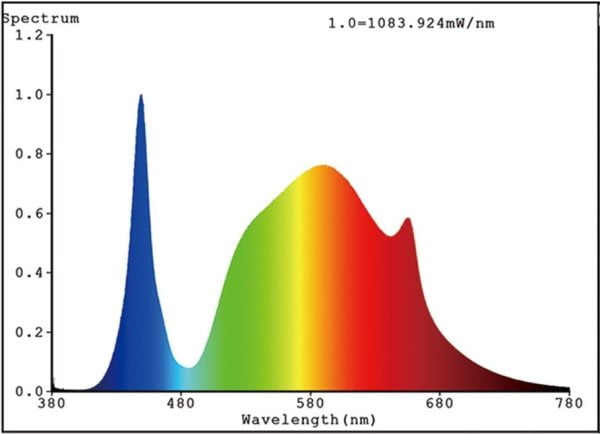
This graph shows the available light spectrum on the newer Mars Hydro LEDs that provide a more complete light spectrum (TSW 2000).
As you can see it gives off much more green and yellow light.
Green Spectrum
This spectrum of light plays a role (albeit minor) in the growth of marijuana plants at various stages. Its wavelength ranges from 495nm to 570nm.
Cannabis plants absorb very little green light energy, but there are reports that small amounts can affect growth.
For most growers, green light isn’t necessary for a successful grow. But, If you feel like growing cannabis with lights that have a more complete spectrum of color then a little bit of green energy is a big yes.
One thing that’s great about green light and cannabis is that it doesn’t trigger flowering. Cannabis is very sensitive to light and dark cycles. A small amount of light during the night period could trick your plants in thinking it’s time to flower. Cannabis doesn’t “see” green light making it the perfect color of light to use if you want to work on your plants during the night period.
Yellow Spectrum
Yellow light energy has a wavelength that ranges from 570nm to 590nm. It is of little importance during photosynthesis but yellow/red light is essential for the flowering stage of the plant’s growth as it promotes budding.
Besides its usefulness in budding and flowering, it’s of very little use to the plant during the vegetative growth stage. Yellow light energy on its own is a minor contributor to photosynthesis.
Red Spectrum
The final color on the visible light spectrum is red. It has a wavelength that ranges from 620nm to 750nm. This light is necessary during the flowering stage of marijuana plants. Adding red light induces budding and flowering. Many cannabis growers will switch to a stronger red light source once their plant gets to the flowering stage. Red light mixed with blue gets the best response from cannabis plants.
What’s The Difference Between Cool and Warm Light?
You may hear people refer to light as either “cool” or “warm”. This describes the colors of the spectrum going from violet to red. Cool colors are on the lower end of the light spectrum (violet, blue, green), while warm colors are on the higher end (yellow, orange, red).
What’s the best color light to use for cannabis seedlings
A seedling will respond best to blue light. Sprouts will stretch and grow tall if there’s not enough blue light available. Not much light power is needed at this stage since the plants are so small. Many growers will use 50 watt cool white CFL bulbs specifically for their seedlings and cuttings.
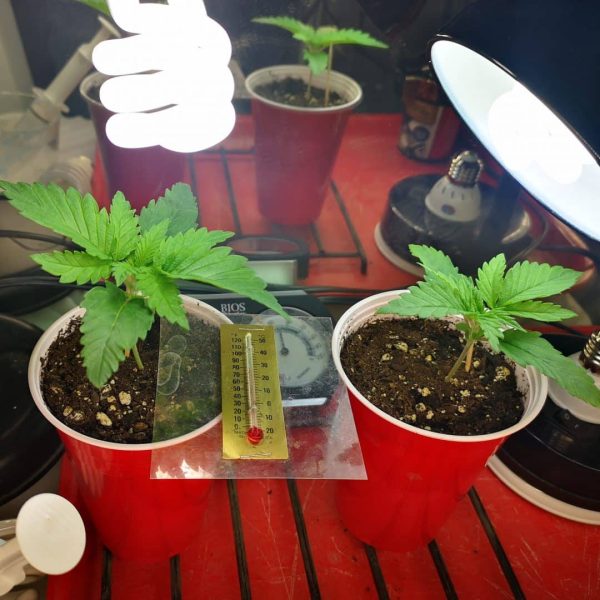
What’s the best color light to use for growing cannabis
During the vegetative stage of cannabis growth, plants react well to lots of blue light. It’s important to also provide some red light too. The combination of blue and red light is the recipe for growth.
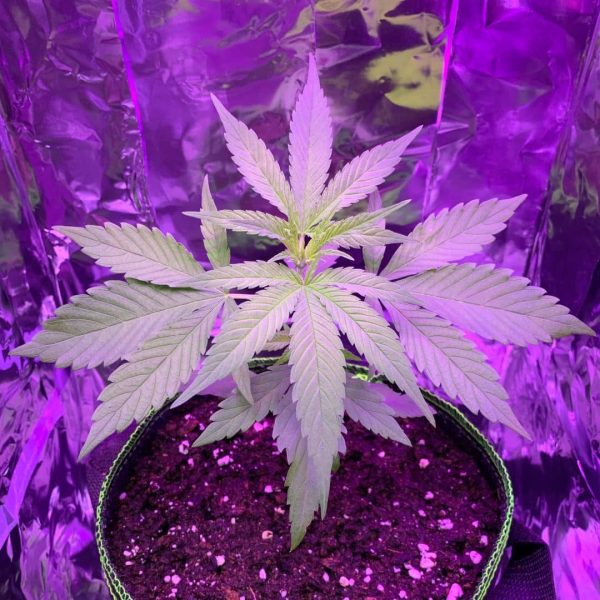
What’s the best color light to use for flowering cannabis
Switching your plants over to light that is heavier in the orange/red part of the light spectrum will help induce flowering as well as improve it. Don’t drop the blue light altogether, it’s still required but in slightly smaller amounts than red and orange light.
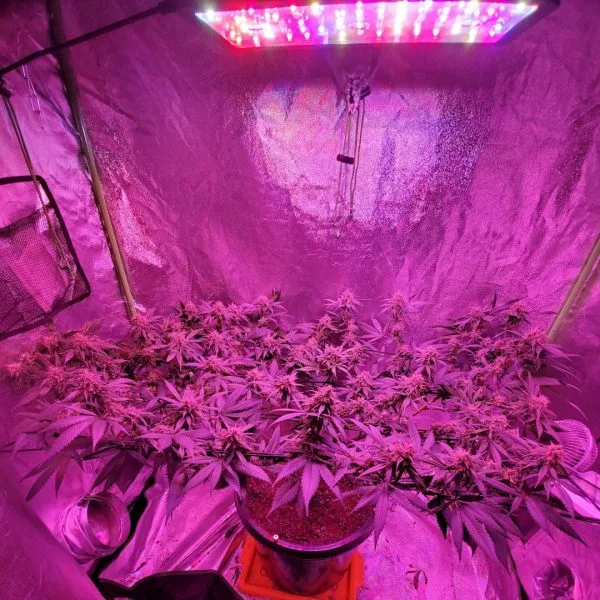
The Bottom Line About Light and Cannabis
Nothing beats natural sunlight. Cannabis plants can grow huge outdoors in the right sunny conditions.
Growlights only give off a fraction of the light energy the sun provides. Using limited spectrum lights are adequate for indoor growing. Blue light and red light will successfully grow a cannabis plant without any problems.
Using grow lights that provide a fuller spectrum of visual light will have an affect on the plant and usually results in a bigger yield. Your decision on using different types of light will depend on your unique situation. If you’re thinking of upgrading your lights, try going for something that better emulates the sun like full spectrum lights made for growing plants.
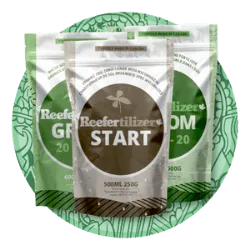
Thanks For Reading
The importance of cannabis to humans cannot be underestimated. It not only slows down cancer cells from spreading, prevents Alzheimer’s disease, treats glaucoma, relieves arthritis but solves a whole lot of other medical issues. Even the act of growing cannabis can bring a great sense of well being.
It takes a lot of different factors to grow good weed and light is a biggie. I hope this article helped you understand how light and cannabis work together. Feel free to ask any questions below.
If you want to learn even more about growing good cannabis, we offer a free 40+ page guide full of images.
Now available on Amazon.
Sign up for our newsletter and download the digital copy today!
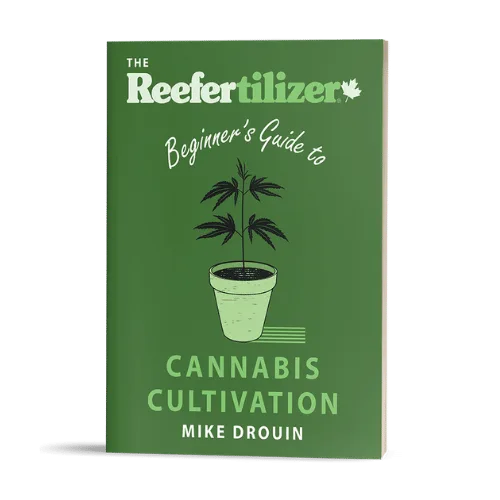
This guide will answer many questions about growing cannabis, like the following...
Selecting Seeds
Identify and Correct Problems
Maximize Yield
Much More...
Get a Chance to INSTANTLY WIN a Reefertilizer Nutrient Kit When You Sign Up.
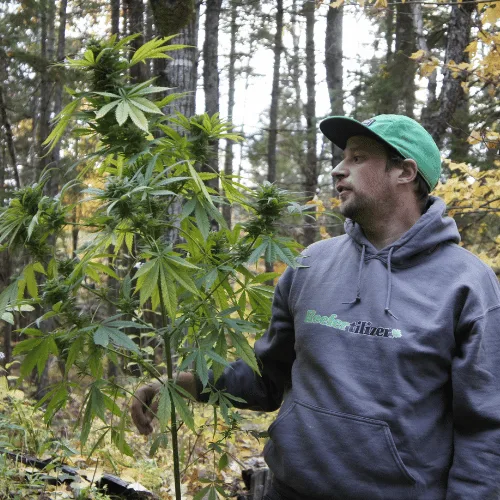
Mike Drouin is the co-founder of Reefertilizer. He’s an experienced craft cannabis grower and a writer of many articles regarding the process. Mike lives on Vancouver Island and enjoys cycling and camping and will sometimes combine the two.


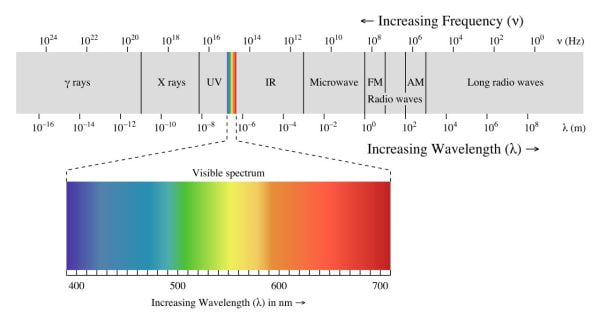
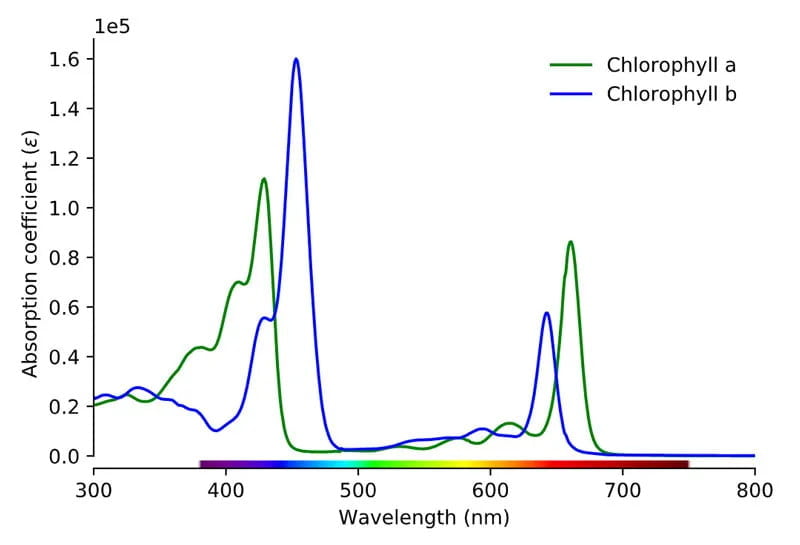
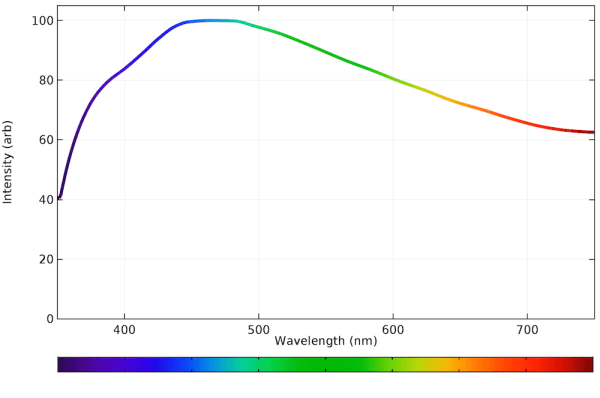
Comments are closed.